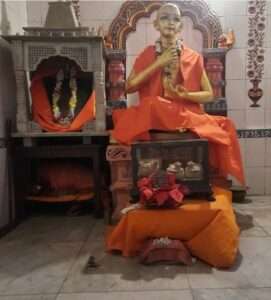
Ratha Yatra
Syamananda Prabhu went to have darsana of Sapta Sarovara, Rama Chandi, Vraja Sarovara, Gargesvara Mahadeva, at the birth place of Sridhara Swami[1], and then went to Gauradanda, where he loudly called the name “Baladeva” three times. At that time nobody could understand whom he was calling, but on his call, at the end of the 17th century AD, Baladeva Vidyabhusana, the prestigious Gaudiya Vedanta commentator, would take birth at that place[2].
After restarting the service and worship of Sri Ksiracora Gopinatha in Remuna, Sri Syamananda Prabhu and Sri Rasikananda Prabhu travelled through Nilagiri, Badagram, Bhadrak, and then had darsana of Saksi Gopala[3].
It was the time of the Ratha-yatra in Jagannatha Puri and both Prabhus and the devotees quickly walked towards Puri to have darsana of Lord Jagannatha’s Ratha. However night fell before they could arrive, and they had to spend the night at a place about 10 miles away from Puri.
The next morning after completing their daily rituals, they started running towards Puri.
Meanwhile, with great pomp the chariot of Lord Balarama, named Taladhvaja, and the chariot of Subhadra Maharani, named Devadalana, left towards Gundica Mandir[4] amidst the sound of conches, kettledrums, mridangas, etc., but the chariot of Lord Jagannatha, named Nandighosa, remained standing in the same place.
When the King of Puri saw that thousands of devotees and his powerful elephants could not make the chariot move forward, he became hopeless. Then one of the chief priests received a message from Lord Jagannatha Himself that His two devotees, Syamananda and Rasikananda, had reached Atharanala[5] and that the chariot would move forward only when they arrived in Puri. The King immediately left for Atharanala with his ministers and brought the two great spiritual masters to Puri.
Arriving at the sound of sankirtana, Syamananda Prabhu circumambulated the chariot and told Rasikananda:
“Push the chariot.”
As soon as he touched the chariot with his forehead to push it forward, to the astonishment of all those present, it started moving forward speedily, and making a thundering sound it reached Gundica Mandir without delay.
The amazed King, Gajapati Sri Langula Narasimha Deva, granted Syamananda Prabhu a permanent residence at a good and secluded place in the flower garden of Lord Jagannatha, where he established the Kunja Math. Years before, after taking sannyasa, Sri Caitanya Mahaprabhu had came to Nilacala and resided in this same place for some days and subsequently moved to Gambhira[6].
[1] The famous commentator of the Srimad Bhagavatam, member of the Visnusvami tradition.
[2] According to some, by calling “Baladeva, Baladeva, Baladeva” Syamananda was calling Baladeva Vidyabhusana to descend.
[3] The “witness Gopala”. There is a very nice story on this Deity, originally installed by Vajra, the great grandson of Lord Krishna. You can find it in Sri Caitanya Caritamrita, Madhya lila, Chapter 5.
[4] Gundica is a temple on the opposite side of the avenue beginning from Jagannatha Temple. During the festival, the three chariots move all the way to Gundica and then return to the main temple. Gundica is a representation of Vrindavana. Lord Jagannatha, who is Sri Krishna, fulfills in this way His desire to go back to Vrindavana by going to Gundica.
[5] Atharanala is a small village not far from Puri.
[6] Gambhira used to be the house of Kasi Misra. He worshiped his Deities Sri Sri Radha Kanta there. Sri Chaitanya Mahaprabhu stayed in Radha Kanta in a very small room called Gambhira. This is the room where Lord Caitanya lived. There is a lamp here that is never extinguished. Lord Caitanya’s wooden sandals, his quilt, water pot, and bed are also inside the Gambhira. Sri Chaitanya lived in this room for 12 years. He would be absorbed in deep ecstasy while He stayed here.
This is a section of the book “Syamananda, the Joy of Radharani (English)”.
To buy the complete book, click above
Post view 469 times



Leave a Reply